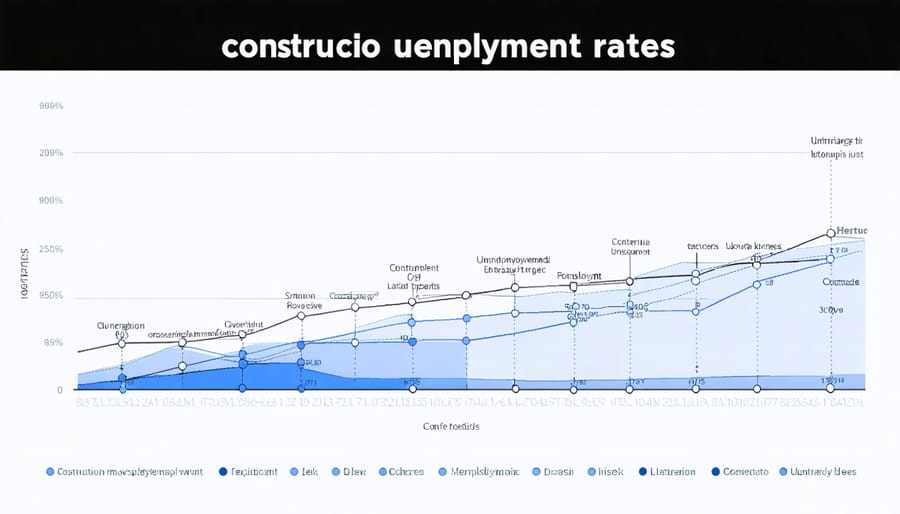The construction industry faces an unprecedented 9.2% unemployment rate as of 2024, marking a critical inflection point that demands immediate action from industry leaders and stakeholders. While cyclical fluctuations in construction employment are common, today’s challenges stem from a perfect storm of factors: persistent skilled worker shortages, rapid technological advancement, and evolving market demands. This complex landscape has created a paradoxical situation where unemployment rates rise even as thousands of construction positions remain unfilled across the nation. For industry professionals and decision-makers, understanding these dynamics isn’t just academic—it’s essential for developing effective workforce strategies and maintaining competitive advantage in an increasingly challenging market. Recent data from the Bureau of Labor Statistics reveals that while the overall construction sector contributes $1.2 trillion to the US economy, workforce instability threatens this economic engine, making it imperative for industry leaders to implement innovative solutions for sustainable employment growth.
The Current State of Construction Employment
Key Statistics and Regional Variations
Recent data from the Bureau of Labor Statistics reveals significant regional variations in construction unemployment rates. The Northeast region consistently shows higher unemployment rates at 7.2%, compared to the national average of 5.4%. In contrast, the Southwest and Western regions maintain lower rates at 4.1% and 4.3% respectively, largely due to sustained residential construction growth.
Specialty-specific analysis indicates that residential construction workers face an unemployment rate of 6.3%, while commercial construction specialists experience a lower 4.8% rate. Heavy civil construction maintains the most stable employment figures with a 3.9% unemployment rate, attributed to ongoing infrastructure projects.
Metropolitan areas demonstrate notable disparities, with major urban centers showing unemployment rates 1.2 percentage points lower than rural regions. Seasonal variations remain significant, with peak unemployment occurring during winter months, reaching up to 9.8% in northern states, while summer months average 4.2% nationwide.
Skilled trade specialists, particularly electricians and plumbers, maintain the lowest unemployment rates at 3.2%, while general laborers face higher rates averaging 7.5%. These statistics highlight the increasing importance of specialized training and certification in maintaining stable employment within the industry.

Post-Pandemic Impact Assessment
The COVID-19 pandemic has fundamentally altered employment patterns in construction, creating both unprecedented challenges and opportunities for industry transformation. Initial lockdowns in 2020 resulted in project delays and widespread layoffs, with approximately 1.1 million construction workers displaced during the peak of the crisis.
Post-pandemic recovery has been marked by distinct shifts in workforce dynamics. While project demands have rebounded significantly, many experienced workers have permanently left the industry, creating a more pronounced skills gap. Survey data from leading contractors indicates that 72% now face greater difficulty finding qualified workers compared to pre-pandemic levels.
Remote work adoption has also influenced construction management roles, with 35% of administrative and planning positions transitioning to hybrid models. Technology integration has accelerated, requiring workers to develop new digital competencies. Safety protocols have evolved, incorporating enhanced health measures that have become standard practice.
These changes have necessitated substantial investments in workforce development, with particular emphasis on digital skills training and cross-functional capabilities. Industry leaders are now prioritizing resilience in their hiring and retention strategies, recognizing the need for adaptable talent in an increasingly dynamic construction landscape.
Root Causes of Construction Unemployment
Skills Gap and Training Deficits
The construction industry faces a significant disconnect between available workforce skills and evolving project requirements. Recent industry surveys indicate that 81% of construction firms struggle to find qualified workers, while 72% report that their new hires lack essential technical skills required for modern construction projects.
This skills gap manifests in several critical areas. Digital competency remains a primary concern, with many workers lacking proficiency in Building Information Modeling (BIM), project management software, and emerging construction technologies. Additionally, there’s a shortage of workers skilled in sustainable construction practices and green building techniques, despite growing market demand for these specializations.
Training deficits compound these challenges. Many construction companies report inadequate internal training programs, with only 35% offering comprehensive skills development initiatives. The rapid advancement of construction technology often outpaces traditional training methods, leaving workers ill-equipped to handle modern equipment and automated systems.
The problem extends to both entry-level and experienced workers. While vocational schools and apprenticeship programs exist, they often struggle to update their curricula quickly enough to match industry innovations. Senior workers, though experienced in traditional methods, frequently require extensive retraining to adapt to digital tools and new construction methodologies.
This misalignment between available skills and industry needs directly impacts project timelines, quality, and costs, creating a cyclical effect on unemployment rates as firms hesitate to hire underskilled workers for increasingly complex projects.
Industry Volatility and Project Cycles
The construction industry’s inherent cyclical nature significantly impacts employment stability, with pronounced boom-bust cycles creating substantial workforce fluctuations. During economic upturns, construction firms rapidly expand their workforce to meet increased demand, often leading to labor shortages and wage inflation. Conversely, economic downturns trigger project cancellations and delays, resulting in widespread layoffs and reduced work hours.
These cycles typically follow broader economic patterns but can be intensified by factors specific to construction, such as interest rate changes, material costs, and regulatory shifts. Recent data indicates that construction unemployment rates can swing by as much as 15-20% during these cycles, creating significant challenges for workforce retention and skill development.
Project-based employment further compounds this volatility. Large-scale construction projects often require substantial workforces during peak phases but significantly fewer workers during planning and completion stages. This creates a “stepping stone” effect where workers must constantly transition between projects, sometimes facing gaps in employment. Industry experts suggest that embracing technological solutions and diversifying project portfolios can help companies maintain more stable workforce levels throughout these cycles.
Technological Disruption
The construction industry is experiencing unprecedented technological disruption in construction, fundamentally transforming traditional job roles and workforce requirements. Automation technologies, including robotic systems for bricklaying and 3D printing of building components, are replacing tasks previously performed by skilled laborers. Advanced building information modeling (BIM) systems and digital twin technology are reducing the need for traditional drafting and design positions while creating demand for tech-savvy professionals.
The integration of autonomous equipment, drones for site surveying, and AI-powered project management tools is reshaping workforce dynamics. While these innovations enhance efficiency and safety, they’re also displacing workers who lack digital skills. Industry data suggests that up to 30% of current construction tasks could be automated by 2030, particularly affecting manual labor positions.
However, this transformation also creates opportunities for workers willing to adapt. New roles are emerging in areas such as digital construction management, drone operation, and BIM coordination. The key to maintaining employment lies in developing hybrid skill sets that combine traditional construction knowledge with technological proficiency.

Strategic Solutions for Workforce Development
Modern Training Programs and Apprenticeships
Modern construction training programs have evolved significantly to address industry-specific unemployment challenges through innovative workforce development strategies. Leading construction firms are now implementing hybrid learning models that combine traditional hands-on training with digital platforms, enabling broader access to skill development opportunities.
Virtual reality (VR) and augmented reality (AR) technologies are revolutionizing apprenticeship programs, allowing trainees to practice complex procedures in safe, controlled environments before working on actual job sites. These immersive training solutions have shown a 40% improvement in skill retention compared to conventional methods.
Industry partnerships with technical schools and community colleges have created specialized certification programs targeting high-demand skills. These accelerated programs, typically lasting 6-12 months, focus on emerging technologies like Building Information Modeling (BIM), sustainable construction practices, and advanced equipment operation.
Modern apprenticeships have also adapted to include micro-credentials and stackable certifications, enabling workers to build qualifications progressively while maintaining employment. This flexible approach has proven particularly effective in reducing unemployment among younger workers and career changers.
Data from the Associated Builders and Contractors (ABC) indicates that programs incorporating mentorship components and cross-training opportunities show a 75% higher retention rate. Companies implementing these comprehensive training approaches report significant reductions in skill gaps and improved project efficiency.
Furthermore, construction firms are increasingly offering specialized programs for veterans and underrepresented groups, creating diverse talent pipelines while addressing industry labor shortages. These initiatives often include support services such as transportation and childcare assistance, removing common barriers to entry-level employment and career advancement.

Industry-Education Partnerships
Industry-education partnerships have emerged as a crucial strategy in addressing construction unemployment through targeted workforce development. Leading construction firms are increasingly collaborating with technical schools, community colleges, and universities to develop curriculum-aligned programs that bridge the skills gap and create sustainable talent pipelines.
These partnerships typically manifest in three key formats: apprenticeship programs, specialized certification courses, and work-study arrangements. For instance, the Associated General Contractors of America (AGC) has established partnerships with over 200 educational institutions nationwide, facilitating hands-on training programs that combine classroom instruction with practical site experience.
Recent data indicates that construction firms participating in such partnerships report a 45% higher success rate in filling skilled positions compared to those operating independently. Notable examples include the Construction Management Partnership Program at Arizona State University, which has achieved an 85% post-graduation employment rate through direct industry involvement in curriculum development and internship placements.
Educational institutions benefit from access to current industry practices, equipment, and expertise, while construction companies gain direct access to qualified candidates trained in relevant skills. Many partnerships also include mentorship components, where experienced professionals guide students through real-world projects and career development.
To maximize effectiveness, successful partnerships often incorporate:
– Regular curriculum reviews with industry input
– On-site training opportunities
– Guest lecture series by industry professionals
– Joint research projects
– Equipment and technology sharing arrangements
– Career fairs and networking events
These collaborative initiatives are proving instrumental in creating a more resilient workforce while reducing unemployment rates in the construction sector.
Technology Integration and Upskilling
The rapid evolution of construction technology demands a strategic approach to workforce development and skill enhancement. Construction firms must prioritize technology integration while simultaneously addressing unemployment through comprehensive upskilling programs. Digital tools, building information modeling (BIM), and automated construction processes are becoming industry standards, creating an urgent need for workers to adapt their skillsets.
Leading construction companies are implementing structured training programs that combine traditional construction knowledge with digital competencies. These programs typically include hands-on experience with emerging technologies such as drone operation for site surveys, virtual reality for safety training, and automated equipment operation. Workers who acquire these advanced skills become more valuable assets, reducing their vulnerability to unemployment during industry downturns.
Case studies from successful implementation projects demonstrate that companies investing in workforce development see up to 25% improvement in project efficiency and a significant reduction in skill-related unemployment. For instance, Turner Construction’s Digital Skills Initiative resulted in a 30% increase in worker retention and a 40% reduction in training-related delays.
Key areas for upskilling include:
– Digital project management platforms
– Advanced equipment operation and maintenance
– Data analytics and reporting
– Building automation systems
– Sustainable construction practices
– Smart building technologies
Industry partnerships with technical schools and vocational training centers are proving essential in bridging the skills gap. These collaborations often provide certification programs that combine classroom learning with practical application, ensuring workers develop both theoretical knowledge and hands-on experience with new technologies.
To maximize the effectiveness of technology integration efforts, construction companies should:
– Conduct regular skills assessments
– Develop personalized training paths
– Establish mentorship programs
– Create technology adoption roadmaps
– Monitor and measure training outcomes
– Maintain continuous learning programs
This strategic approach to technology integration and upskilling not only addresses current unemployment challenges but also prepares the workforce for future industry demands, creating more resilient and adaptable construction professionals.
The construction industry’s unemployment landscape continues to evolve with significant implications for the sector’s future. Our analysis reveals that while cyclical unemployment remains a persistent challenge, structural changes in the industry are creating new opportunities alongside emerging challenges. The increasing adoption of advanced construction technologies and sustainable building practices is reshaping workforce requirements, demanding a more skilled and adaptable labor pool.
Looking ahead, industry projections suggest a mixed outlook. While some regions may continue to experience labor shortages, others might face periodic unemployment spikes due to project cycles and economic fluctuations. The key to addressing these challenges lies in strategic workforce development, including comprehensive training programs, improved retention strategies, and stronger partnerships between industry stakeholders and educational institutions.
The future of construction employment will likely depend on several critical factors: the industry’s ability to attract and retain skilled workers, successful implementation of technological innovations, and adaptation to changing market demands. Companies that invest in workforce development and embrace digital transformation are better positioned to maintain stable employment levels and competitive advantages.
For sustainable improvement in construction employment rates, stakeholders must focus on creating more resilient workforce strategies, enhancing industry attractiveness to younger generations, and developing more flexible employment models that can better weather economic uncertainties. This comprehensive approach will be crucial for building a more stable and sustainable construction workforce for the future.

